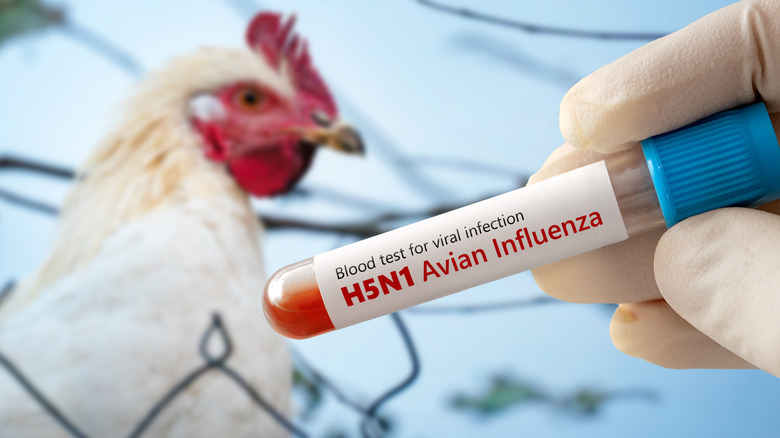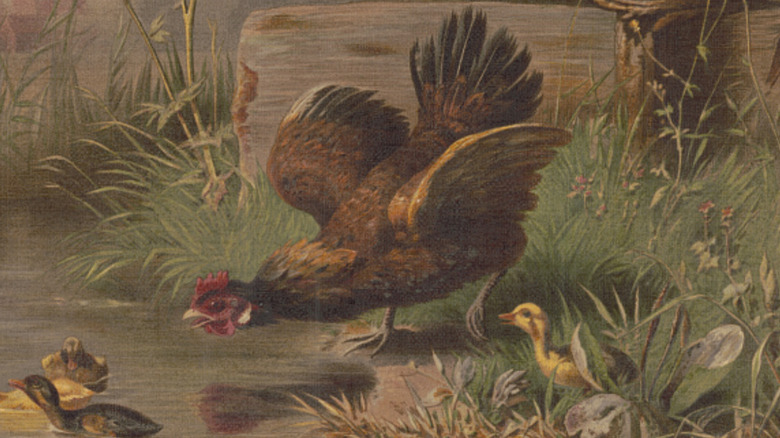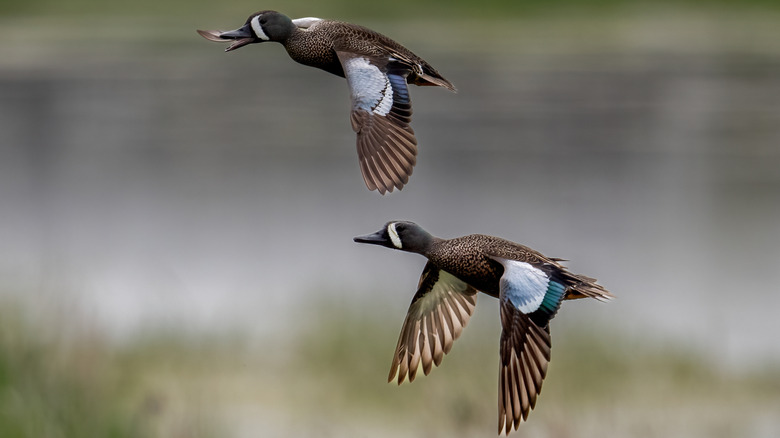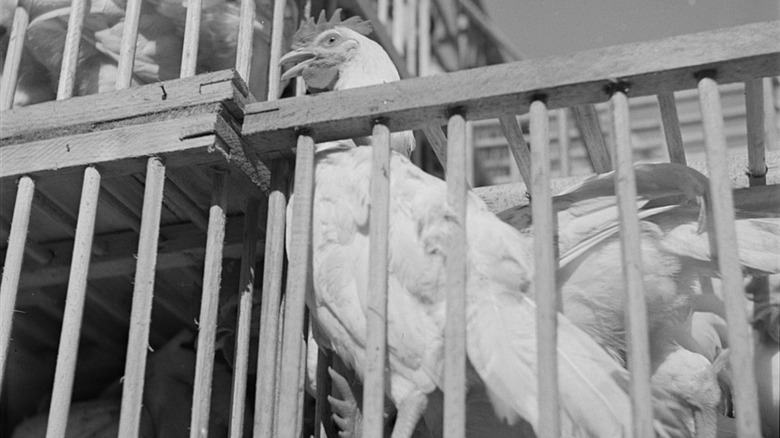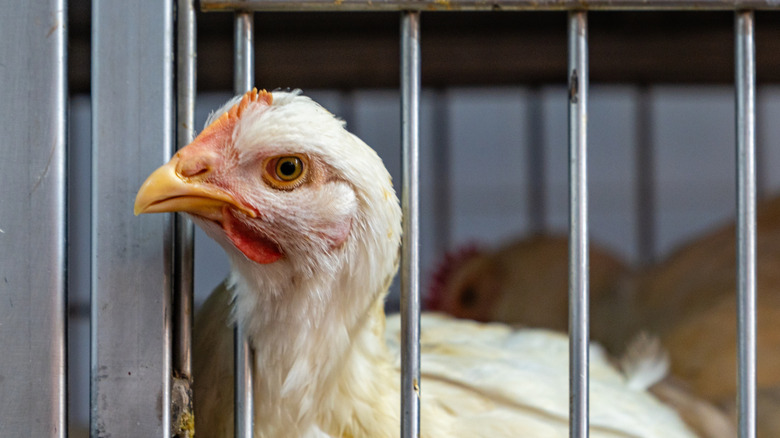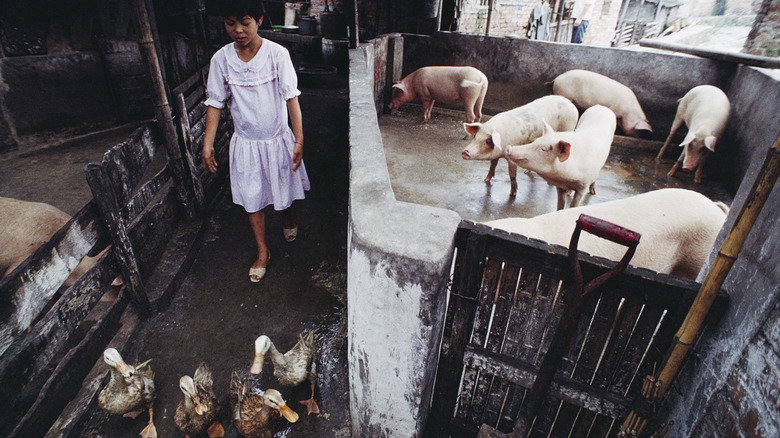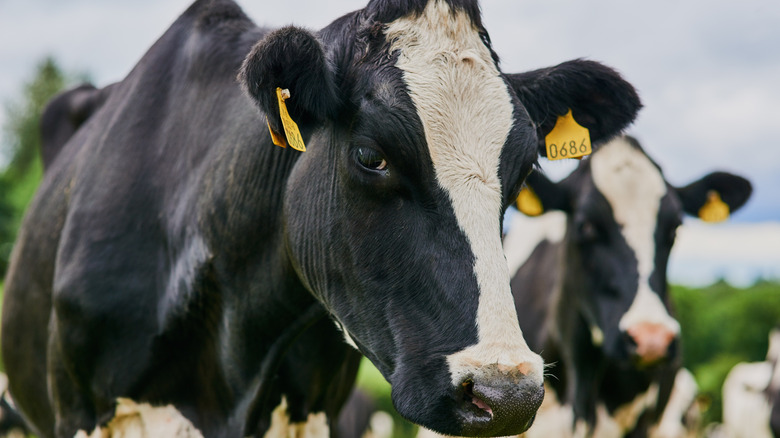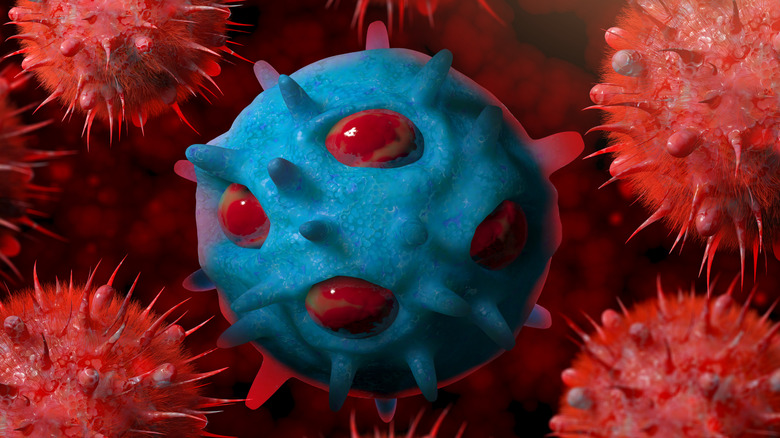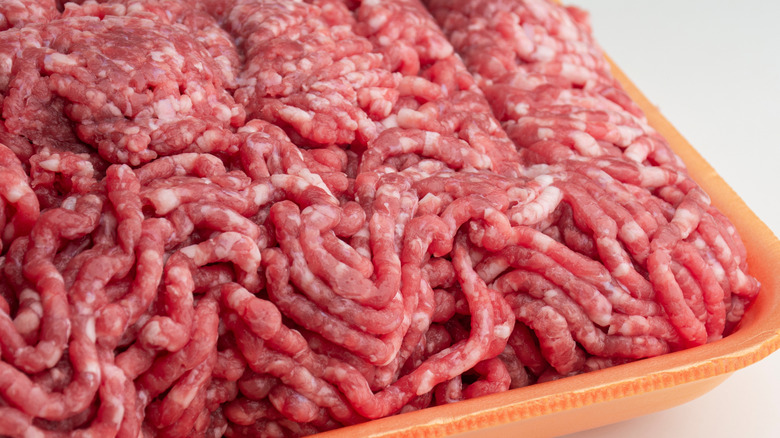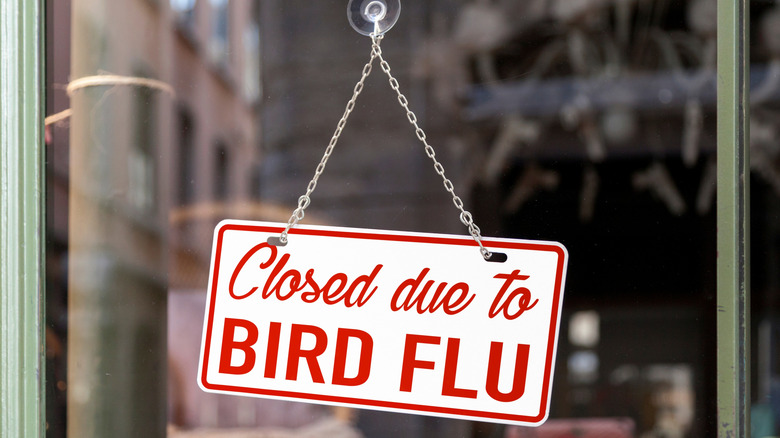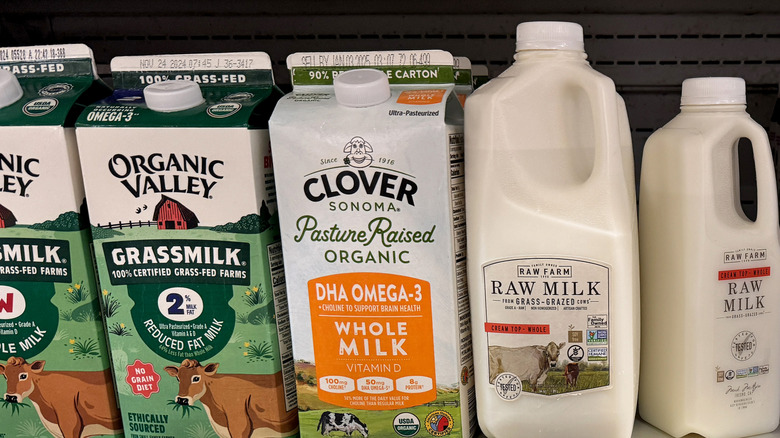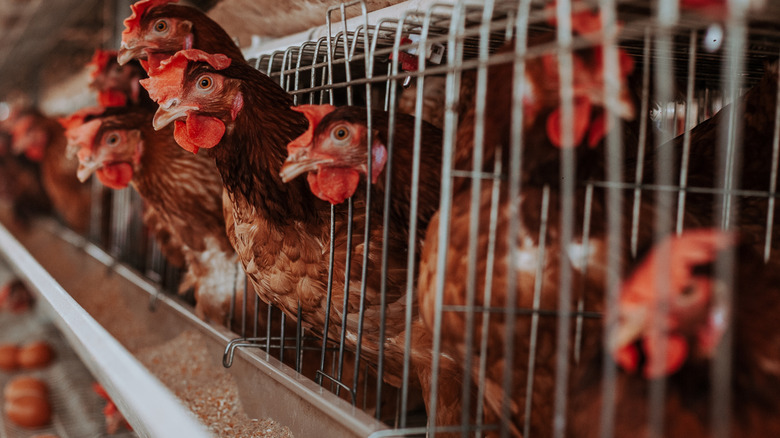What Is Bird Flu And How Does It Affect Food?
Bird flu, also known as avian influenza, or H5N1 bird flu, has dominated headlines worldwide in 2025. The virus is one of the reasons behind surging egg prices and widespread shortages of other grocery store items, like milk. On January 6, 2025, the U.S. Centers for Disease Control and Prevention (CDC) reported that an individual in Louisiana had died after contracting bird flu. All of this disconcerting news may leave you wondering: what is bird flu anyway?
Bird flu is exactly what it sounds like: an influenza virus that affects birds. Bird flu is a human problem too, because it affects many food products that we consume. Eggs, poultry, and other farm-fresh items like beef and milk are vulnerable to bird flu's destructive nature. Although the average human is not in impending danger of contracting bird flu, concerted efforts must be made to keep potentially infected food and drinks out of commercial marketplaces in the name of public health.
It's also important to consider that humans aren't the sole consumers of store-bought foods that may be contaminated by bird flu. Domesticated cats and dogs also eat poultry, meats, and cheeses. Pets who contract bird flu from food are at higher risk of dying from their illness. To better understand bird flu's link to food, one has to look at the history behind the illness. This is the story of bird flu, its effects on food, and how us humans can prevent the illness from spreading.
The earliest record of bird flu is from 1878
A spell of bird fatalities in the 1870s propelled what would become the earliest scientific insights on bird flu. It was an era well-versed in epidemic illness — cholera and scarlet fever claimed large numbers of lives back then, but bird flu proved to be something altogether different. In 1878, Edoardo Perroncito, a professor, veterinarian, and parasitologist in Northern Italy was preparing a report on a deadly illness outbreak that was wiping out the region's poultry population. Perroncito noted that the epidemic was virulent in nature, as opposed to fowl cholera, which was caused by bacteria. It was the first time this distinction was formally made.
Perroncito's analysis served as the blueprint for continued research of what became known as "fowl plague" and later, bird flu. By 1901, scientists were able to identify the virus that caused fowl plague as a filterable agent, meaning it could pass through the small pores of a ceramic filter and remain infectious while the bacteria and yeast associated with it were left behind. Fowl plague was the second ever virus (after foot and mouth disease) to be identified using this filtration technique, which was a cutting edge method at the time. As time would tell, these early breakthroughs in the epidemiology of bird flu, only scratched the surface of the virus' complexity and its potential to affect food.
The origins of bird flu can be traced to migratory birds
Scientific knowledge about the virus responsible for bird flu increased considerably since it was first studied in Italy in the late 19th century, yet the source of the disease wasn't pinpointed until much later. In 1975, the World Health Organization (WHO) selected St. Jude Children's Research Hospital in the U.S. as a Collaborating Center for Influenza. WHO's decision led to some scientific breakthroughs.
Robert Webster, a scientist at the helm of St. Jude's influenza research, got the idea to test mutton birds for influenza after seeing their dead bodies scattered along a beach in New South Wales, Australia. It took a year, but Webster successfully isolated the virus in the mutton birds. He followed up his findings by collecting samples from wild ducks throughout North America. Webster found that even ducks who appeared healthy, carried the virus and antibodies in large amounts. Ducks had been on the radar for awhile.
During a bird flu outbreak in the mid-1950's, researchers in England and the former Czechoslovakia found a unique strain of type A influenza in ducks with acute respiratory illness. When a scientist working with Webster at St. Jude's found that the flu virus was replicating in the intestines, it shattered all previous notions that migratory birds develop influenza in their respiratory tracts. The plot thickens. In 2023, a flu virus found in a Siberian sturgeon suggests that the earliest influenza viruses on earth may have been carried by fish.
A bird flu outbreak in 1924 was the first of its kind in the U.S.
After bird flu was first detected in Northern Italy circa 1878, it was only a matter of time before more recorded cases of outbreaks resembling the "fowl plague", began popping up in other parts of the world. The first documented wave of bird flu to affect the U.S. happened in 1924. The outbreak occurred on the East Coast, and live bird markets were thought to be the source of the problem.
Bustling markets, particularly in urban areas like New York City, brought a lot of different bird species into cramped, not-so-sanitary quarters. Birds that needed to be transported to the live markets were packed into cages and loaded into dark, stuffy train cars. This created a literal hotbed of germ-spreading before the birds even reached their intended destination. It was not uncommon for some birds to die along the way.
In light of scientific evidence that bird flu is hosted by migratory birds and commonly transferred to chickens, it's no surprise that the American live bird markets of the 1920s were afoot with influenza. While there aren't solid accounts of how bird flu was detected in these markets, the outbreak was contained and did not result in any known cases of human illness. What transpired in those live bird markets cemented bird flu's first official arrival in the U.S., but it would not be the last.
The term avian influenza was coined in 1981
For nearly 100 years, the term "fowl plague" was used to differentiate the virus from fowl cholera, an illness caused by the bacterium Pasteurella multocida. In 1981, fowl plague was renamed avian influenza. This was due in part to the virus' connection to the 1918 influenza pandemic that killed between 50 million and 100 million people worldwide, commonly referred to as the Spanish flu (it actually originated in the U.S.).
While the Spanish flu ravaged the human population, a similar outbreak was killing off swine. The respiratory illness detected in swine in 1918 was a suspected cause of the outbreak in humans, or vice versa. Much later, scientific studies would prove this theory incorrect. As epidemiological research progressed, scientists learned that the outbreaks afflicting humans and swine back in 1918 were adaptations of an avian flu virus.
Comparative testing of preserved specimens from humans who died of Spanish flu and waterfowl preserved in a 70% ethyl alcohol solution circa 1918, showed that the H1N1 strain of type A influenza that killed so many people had significantly mutated from the avian sequences. In other words, the flu was not passed directly from bird to human, but there was a genetic link. Fowl plague's status as a type A influenza virus was identified in the aftermath of a 1955 fowl plague outbreak. At the First International Symposium on Avian Influenza in 1981, the term fowl plague was permanently replaced by the common name "bird flu".
What is the connection between bird flu and humans?
All over the world, live markets are a popular place for consumers to purchase farm fresh eggs, poultry, and meat. Live markets, sometimes called wet markets, are one setting where humans are at a higher risk for contracting bird flu. The overall likelihood of a bird flu outbreak in humans is low, but it has happened. The first time was in 1997, in Hong Kong.
In 1996, bird flu was detected in domestic geese in Guangdong, a province in Southern China. The type A flu strain present in the geese was a highly pathogenic avian influenza (HPAI) known as H5N1. This strain was first identified in 1955 after a bird flu outbreak on a chicken farm in Scotland. One year after H5N1 showed up in geese in Guangdong, 18 human cases of bird flu were reported in Hong Kong. Six people died. By the early 2000s, H5N1 in humans spread to other countries, including India, Indonesia, Thailand, Egypt and Nigeria. Meanwhile, other bird flu strains infected people in Canada, the Netherlands, and China.
Humans can get bird flu if they come into contact with the feces, saliva, or other bodily matter (such as raw milk) of carrier animals. Since 2003, there have been 954 reported cases of H5N1 in humans and 464 deaths. Human-to-human spread of bird flu is rare. Between 1997 and 2023, there have been eight known instances of individuals sickened by bird flu spreading the virus to family members.
Cows get bird flu too
Wild birds are natural carriers of bird flu and chickens are associated with spreading the illness, but bird flu affects many different animals. Cows were implicated in the ongoing H5N1 bird flu outbreak on March 25, 2024. As of February 2025, the outbreak has affected 972 herds of dairy cattle across 17 states. This is the first time the H5N1 HPAI has spread from birds to cows.
Cows getting bird flu poses a concern for humans as well, particularly those who work with cattle or have raw beef or unpasteurized milk on their grocery lists. To lessen the potential impacts of the H5N1 outbreak in cattle, the United States Department of Agriculture (USDA) is requiring all lactating dairy cattle to be tested for bird flu before they can be transported across state lines. In December 2024, the USDA also launched a National Milk Testing strategy (NMTS) that requires raw milk samples from all dairy processing facilities nationwide to undergo testing.
In January 2025, NMT's efforts detected the D1.1 genotype of type A influenza in cattle in Nevada. Prior to this, all H5N1 cases in cows were associated with genotype B3.13. The D1.1 genotype found in the Nevada cattle was the same one found in migrating North American birds, domestic birds, and mammals. According to the CDC's recent data, 68 people have contracted bird flu in the current U.S. outbreak, and 41 of them named cattle as their exposure source.
There have been some major bird flu outbreaks in the 21st century
The H5N1 bird flu outbreak that has spiked egg prices and caused poultry shortages has been going on since December 2021. In the early days of this outbreak, the H5N1 HPAI virus was found in wild birds and turned up in a commercial poultry plant shortly after. The outbreak has also infected barnyard mammals like cows, goats, and pigs. As of May 2022, upwards of 23 wild mammal species have also contracted H5N1 HPAI. This outbreak is the latest of many that occurred in the 21st century.
In 2002, a bird flu outbreak in Chile was traced to commercial poultry and a human case of H7N2 bird flu was detected in the U.S. Two separate bird flu genotypes affected bird and human populations in 2003 — one in the Netherlands and the other in Asia. In 2004, bird flu outbreaks were documented in Canada, the U.S. and various Asian countries. Again, the illnesses affected poultry and humans. From 2003 to 2005, wild birds were responsible for spreading H5N1 throughout Africa and the Middle East.
Avian influenza was also involved in the 2009 health scare known as swine flu. The swine flu virus was a never-before-seen strain of H1N1 that emerged in the U.S. and spread worldwide. This novel H1N1 virus was a combination of swine, human, and avian flu genotypes. Between 2011 and 2017, various bird flu genotypes infected domestic poultry, wild birds, humans, and cats all over the world.
What foods are most impacted by bird flu outbreaks?
As concerns over bird flow continue to infiltrate the media, public concern over which foods may contain bird flu has grown. The CDC stresses that as of February 2025, risk for a human outbreak of bird flu in the U.S. remains low. Still, certain foods carry a higher risk for bird flu contamination than others.
Shell eggs have been a major concern. Although the shells of eggs have the potential to contain bird flu, biosecurity measures enforcing the sanitation of eggs intended for sale greatly reduces the likelihood of avian flu-tainted eggs reaching store shelves. That said, eggs procured from at-home chicken or purchased at farmer's markets should be washed prior to eating. Thoroughly cooking eggs will also curb the risk for consumer illness.
The bird flu virus is also turning up in cows' udders, which makes raw milk a risky beverage to consume. Pasteurization kills the influenza virus in farm-fresh products, so it's best to stick with items that have undergone this process. Raw beef products and beef-based broths may also make consumers uneasy these days. Federal health officials assure that as long as these foods are cooked to a safe temperature (an internal temperature of 160 degrees Fahrenheit is recommended for beef), the bird flu virus would not be able to survive within them.
Bird flu has significant impacts on the economy and food supply
The most effective way to stop the spread of bird flu is to cull, aka kill the animal groups carrying the virus. Culling infected animals has accounted for hundreds of millions of fatalities. When H5N1 HPAI killed six people in Hong Kong in 1997, an estimated 1.4 million chickens and other domestic birds were killed as a precaution. When H5N1 reemerged in the region between 2001 and 2002, another 2.5 million birds were euthanized. These losses have drastic effects on the agricultural industry.
Other animal species contracting bird flu — known as spillover — is another economically detrimental aspect of bird flu outbreaks. In March 2024, farm-raised goat kids tested positive for H5N1 bird flu for the first time ever after the virus infected chickens on the same property. That same month, cattle herds on farms in Kansas and Texas detected bird flu in their cattle herds. In response, farmers have sent cows who did not recover from the illness to slaughter.
Since 2022, the culling of over 148 million birds has been ordered as a means to reduce bird flu. Less birds means less eggs and as we've seen, the egg shortage has driven their cost sky high. Some stores are also limiting the quantity of eggs one customer can buy. Now, dairy producers face a similar challenge. Data from August 2024 showed that milk production in the U.S. had been on a steady decrease for 14 months.
What happens when you eat or drink something contaminated by bird flu?
Bird flu in humans is transmitted through the eyes, nose, or mouth. This means that ingesting food or drink tainted by the bird flu virus is a surefire way to get sick. People who drink unpasteurized (raw) milk, prepare unwashed shell eggs, or eat improperly cooked beef products may be vulnerable to the adverse effects of bird flu. But what are the symptoms?
Bird flu in people presents in a similar way as the seasonal flu virus more commonly experienced by humans. Fever, cough, sore throat, a runny or stuffy nose, muscle or body aches, headaches, fatigue, and shortness of breath are typical symptoms found in individuals with bird flu. Another telltale sign is redness and irritation of the eyes similar to pink eye. Less common symptoms of bird flu are those that present more like food poisoning. These include nausea, vomiting, diarrhea, or seizures.
Household pets that come down with bird flu could experience the sickness more intensely. The ongoing bird flu outbreak has proven particularly deadly for cats, some of whom have contracted the illness through all-natural pet food containing raw turkey — resulting in one of the stranger recalls in U.S. history. Respiratory issues, heavy discharge from the nose and eyes, severe depression, and neurologic troubles including tremors, seizures, or blindness are the symptoms associated with cats who have bird flu.
How can bird flu be controlled?
The influenza virus becomes especially dangerous when genotypes mutate to form novel strains of the virus that the body isn't prepared to fight off. Preventing viral mutation in bird flu starts with stopping the spread of the illness altogether. The most straightforward way to do this is limiting the sources of exposure.
Individuals who work closely with farm animals should practice good hygiene. Wearing personal protective equipment (PPE) such as a face mask and gloves while handling these animals and properly disposing of used PPE once finished is a good way to start. People who handle wild birds, such as hunters, should also wear PPE. Anyone who comes into contact with animals at risk for hosting bird flu should always wash their hands with warm, soapy water.
In February 2025, the state government of New York ordered a temporary ban of live bird markets after bird flu cases cropped up in the New York City area. The USDA urges that sick or newly received animals should be quarantined away from communal spaces for at least 30 days. Transparency regarding bird flu outbreaks is also crucial to prevention. Not only does this help scientists accurately analyze and report data, it promotes the proper carcass disposal of animals that die from bird flu. These measures take a collective effort, but they are crucial in keeping bird flu's dangers to animals, people, and food at bay.
